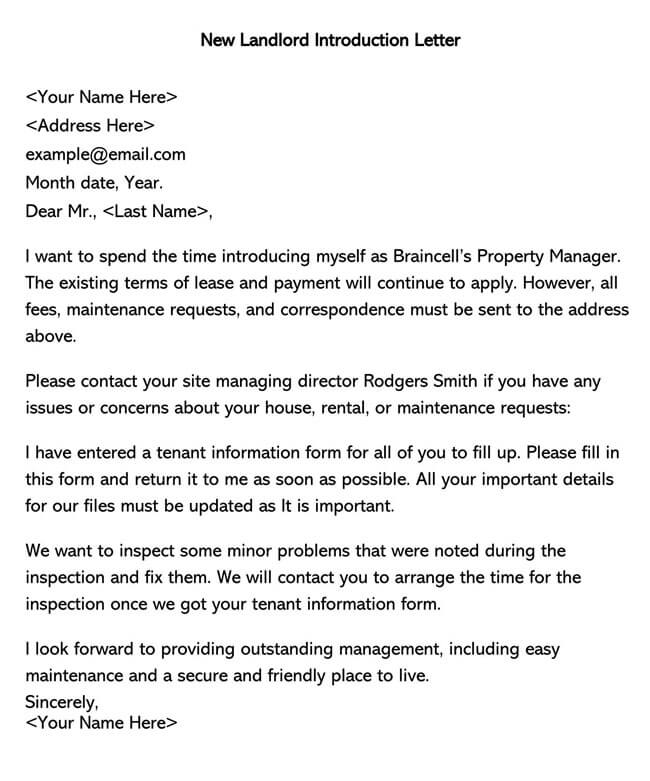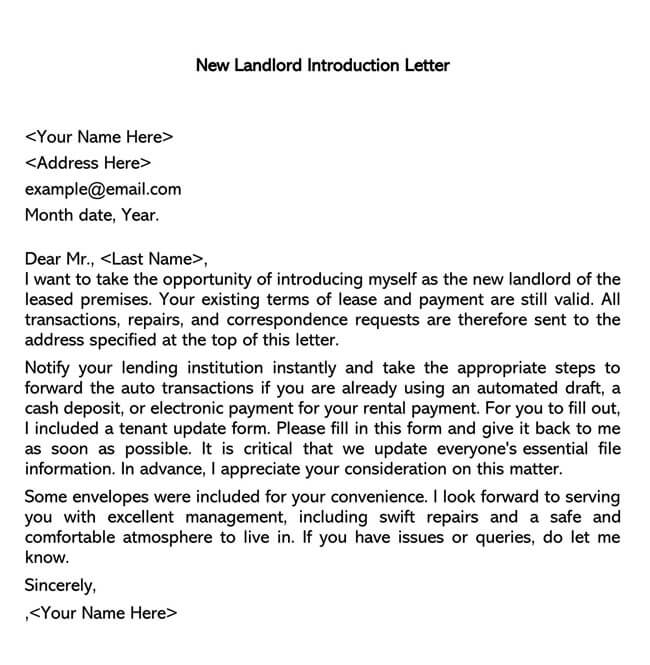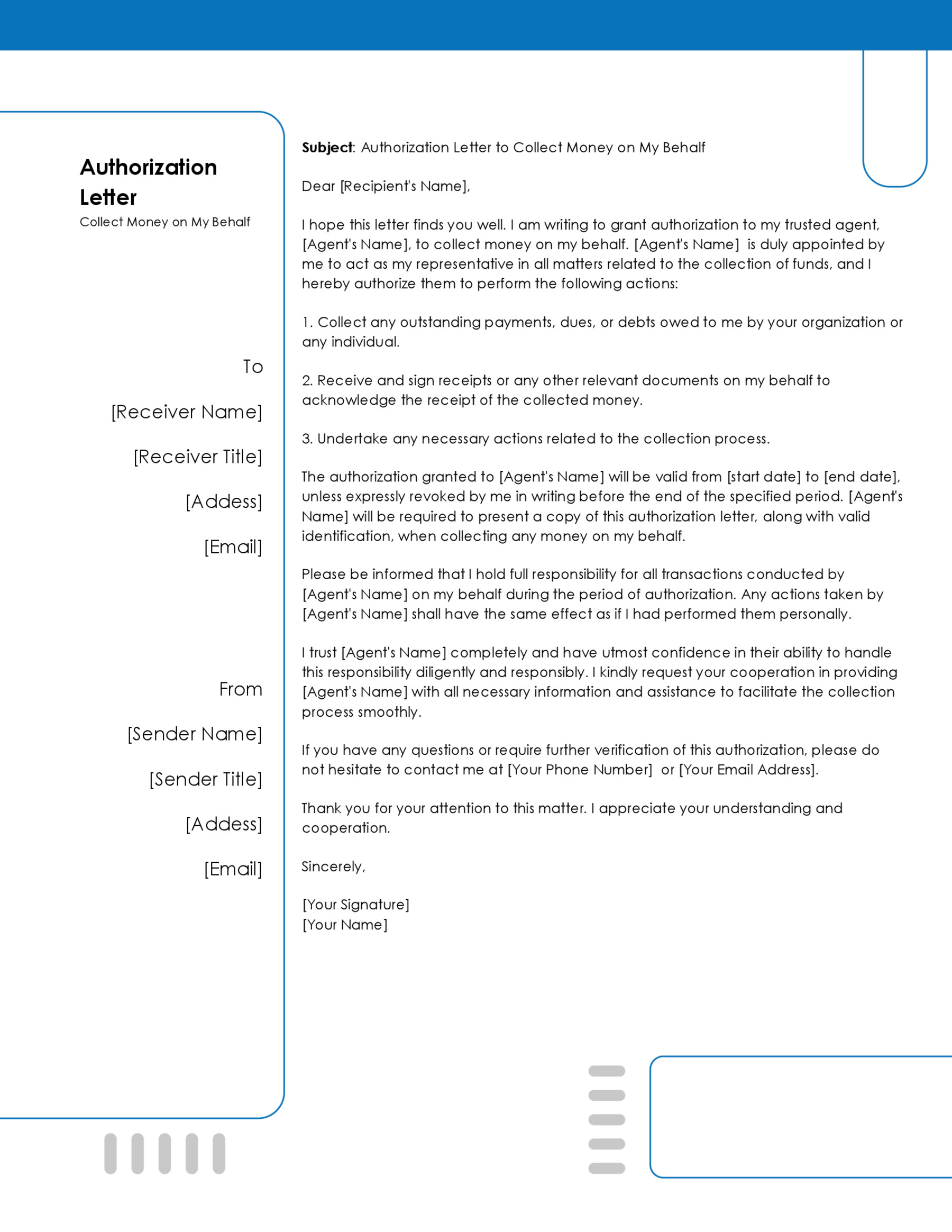Property ownership changes occur regularly. Maybe you found new apartments that you would like to own, or you are no longer interested in the current one. If you’re purchasing a new property, it’s a good idea to identify yourself as the new landlord. This is important as it informs your new tenants where they will start paying their monthly rent. There are many ways in which property owners can alert tenants to personal changes. Issuing new landlord introduction letters is the most common way. It is important to provide tenants with an introduction letter. This may be due to selling a rental property, a landlord changing his estate’s control, or a landlord moving away from self-management.
Writing a new landlord’s introduction letter is not that hard. But just in case, this article will guide you on how to write one and also give you more knowledge on this topic.
What is an Introduction Letter
An introduction letter is a type of letter used to introduce someone you know to someone else. They can help develop working connections that contribute to job opportunities, company development, and partnerships.
In this case, an introduction letter is used to introduce a new landlord to the tenants, informing them of a change in ownership.
Download Free Templates


New Landlord Introduction Letter
The letter informs tenants of a change in ownership in a rental property. When a landlord plans to contract a property management company to take care of his tenants and property, reminding the tenants of the change is crucial for a successful transition process. Introducing new managers keeps your tenants interested in the transformation process and provides them with details on rent payments and how to send maintenance requests.
Things to Include in an Introduction Letter
All letters have elements and information that make them a complete letter. The letter is no exception. Before beginning your letter, make sure you know all the vital information you need to include.
Below is the information you should include in your letter:
- Start by briefly introducing yourself or the property management company that will be taking over the property. State the name of the company and website, if there is one.
- Attach a tenant form to your letters, which they will fill in with their information. The information could include details such as their names, contact information, number of vehicles, etc.
- The next important piece of information is details about rent payments. Give information on the new processes for paying rent and who will be collecting the rent. Provide a bank account where the tenants will deposit rent if needed.
- Proceed to include your contact information for the new property manager in case the tenants want to reach you/them should any issues arise.
- Lastly, explain to the tenants how they should submit their maintenance requests. It can be through email, phone, or a middle-man/caretaker. Indicate the necessary steps they should take when doing this.
Additional details
There is some additional information that many people forget to include in their introduction letter. Information like inspection dates, tenant update forms, and property manager information are crucial.
Below are the additional details that we think you should consider adding to your letter.
Tenant update form
In some countries, updating the details of a tenant is required by law. This is when new residents move in, a contract is renewed, a new management firm takes over, or the terms and conditions of the lease are updated. Therefore, you should include this form in your letter. It contains tenant details such as their names, contact information, pets, vehicles, etc.
Property inspection date
Include a date when you will conduct a property inspection. This is a great chance to meet your new tenants and talk about any maintenance that needs to be done. You can also show them how to submit their maintenance issues.
Property manager
If you bought property owned by a property management company and want to keep the tenants, or maybe you want to change the property management company, include this information in your letter. However, keeping the same management will help you introduce yourself to your new tenants.
Sample Introduction Letters
Now that you know what you should include in your letter, you have a rough idea of how to write one. But for a better understanding of what it looks like, we have included two samples below to guide you and to help you know the format of the letter.
Letter 1: Introduction to New Property Management
Subject: Welcome from New Landlords – Bright Future Property Management
Dear Tenants,
I hope this letter finds you well. My name is John Smith, and I am writing to introduce myself as the new owner of Oakwood Apartments. Our property management operations will be handled by Bright Future Property Management, and you can learn more about us on our website at www.brightfutureproperties.com.
Enclosed with this letter, you will find a Tenant Information Form. We kindly request that you complete this with your details, including names, contact information, number of vehicles, and other relevant information, and return it to us at your earliest convenience.
Regarding rent payments, we are implementing a new process. Starting January 1st, 20XX, rent should be deposited into the following bank account: Bank of Riverdale, Account No: 123456789. Lisa Thompson will be responsible for collecting the rent.
For any concerns or queries, you can reach our property manager, Emily Rodriguez, at emily@brightfutureproperties.com or call us at 555-1234. We are committed to ensuring a smooth transition and addressing any of your needs.
Lastly, should you have any maintenance requests, please submit them via email to maintenance@brightfutureproperties.com or call us at 555-5678. In the case of urgent issues, please contact our caretaker, Mark Johnson, directly.
Thank you for your cooperation, and we look forward to a positive landlord-tenant relationship.
Sincerely,
John Smith
Bright Future Property Management
Contact: 555-1234
Letter 2: New Property Management Announcement
Subject: Your New Living Experience at Skyline Residences
Dear Skyline Residents,
Greetings! I am Alice Hartley, thrilled to inform you that Hartley Real Estate Group is now overseeing Skyline Residences. Discover our vision and services at www.hartleyrealestate.com.
In our endeavor to know you better and serve you efficiently, we request that you fill out the enclosed Lifestyle Preferences Questionnaire. It focuses on your interests in community activities, preferences for amenity enhancements, and additional services you might value.
We are excited to introduce a modernized digital rent payment system. Effective April 15th, 20XX, you can conveniently pay your rent online via our secure portal, accessible at www.hartleyrealestate.com/payments. This portal also allows you to view your payment history and download receipts.
For personalized assistance, our dedicated community manager, Sarah Jennings, is available at sarah@hartleyrealestate.com or 555-7890. Sarah is your go-to person for all your residency needs.
We are launching a new maintenance request system. Please log your issues on our dedicated app, “Hartley Home Care,” available on both Android and iOS. This app offers real-time updates on your maintenance requests and schedules. For emergencies, our 24/7 hotline is 555-6543.
We are committed to making Skyline Residences not just a place to live, but a community to belong to.
Kind regards,
Alice Hartley
Hartley Real Estate Group
Contact: 555-7890
Analysis
Both sample letters reveal several key elements that make them effective for announcing a change in property management. These elements not only fulfill the basic requirements of a well-written letter but also provide a comprehensive guide for anyone looking to draft a similar communication.
- Each letter clearly states its purpose at the outset. This direct approach ensures that the recipient immediately understands the letter’s significance.
- Both letters include essential details such as new rent payment procedures, contact information for various roles (property manager, maintenance, etc.), and instructions for completing and returning the Tenant Information Form. This comprehensive approach ensures that tenants are well-informed about the changes and their implications.
- Offering various means of contact (email, phone) for different needs demonstrates a commitment to accessibility and tenant support. This approach makes it easier for tenants to reach out with their specific concerns.
- Both letters maintain a professional yet friendly tone, balancing the formal nature of the communication with a sense of approachability. This helps in building trust and rapport with the tenants.
- The inclusion of emergency contact information indicates a well-thought-out approach to tenant safety and immediate concerns, showcasing the management’s preparedness and responsibility.
- Each letter concludes on a positive note, emphasizing a commitment to a good landlord-tenant relationship and a high standard of living. This optimistic outlook fosters a sense of community and goodwill.
Both letters serve as useful templates for property management communications, as they cover all necessary information in a clear, concise, and organized manner. They are not only informative but also reassuring, ensuring that tenants feel supported and aware of how the changes will affect them.
Termination of the Current Lease
Depending on the type of lease agreement, there are two steps you need to take if you want to terminate the current lease agreement.
Below are the two steps explained in detail:
Terminating fixed-term leases
If you inherit tenants who are on a fixed-term lease, they are entitled to continue living at your new property for the entire duration of the lease agreement they initially signed. You and the tenants have to reach a mutual agreement if you want to terminate the lease early. You could offer to cover their moving costs as an incentive to encourage them to move.
Terminating monthly leases
If your tenants are on a month-to-month/monthly lease, they are not entitled to stay after a property sale. You only have to give them a written notice of their residency’s final date if you want them to move. You should provide them with the notice thirty to ninety days in advance. The duration depends on the country you are in.
Lastly, some states are starting to pass protection laws such as ‘no cause evictions’ for tenants. Therefore, it is important to review local regulations.
Frequently Asked Questions
A new landlord introduction should be about three-quarters of a page with about three to five paragraphs.
The introduction letter is given to tenants to inform them of a change in ownership and other information like the amount of rent to be paid.
The letter provides you with the opportunity to assure your new tenants that their original lease arrangement will still apply and will be upheld.
Conclusion
Writing a simple, brief letter welcoming new management to your tenants is a perfect way to ensure that they are updated with current property changes. The procedures for paying rent and issuing maintenance reports can be different, for example, so it is important that your tenants are aware of them. The letter can come from the landlord, the property manager, or the property management company itself. It should be professional and detailed, specifically describing any adjustments that require the attention of a tenant.
We hope that the information we have given in this article has given you a better understanding of an introduction letter, how it looks and how to write one.












